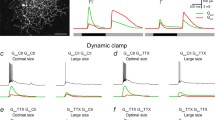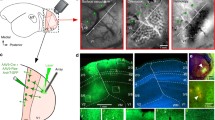Summary
-
1.
Action potentials of single, myelinated optic tract fibers were recorded stereotactically in light-adapted cats (pentobarbital anaesthesia, Curarine-Flaxedil immobilisation). The response of on-center neurons whose receptive fields were within a radius of 15 degrees around the area centralis were measured and quantitatively analyzed by means of a digital computer. Two small light spots of 0.22 degree diameter and 0.15 degree horizontal distance were projected to the RF-center. The luminance of the light spots was varied sinusoidally in time (0.5 to 35 cps) and the phase angle ϕ between the two sinusoidal stimuli changed in 8 steps between 0 and 360 degrees.
-
2.
With a gradual change in ϕ on-excitatory periods elicited by one stimulus could be superimposed on off-inhibitory periods elicited by the other light stimulus and vice versa. The neuronal response (average impulse rate\(\bar R\), maximal impulse rateR max) depended on cos ϕ/2 (eqs. 4 and 6). The average neuronal activation further depended on the stimulus frequency; the relative relationship between cos ϕ/2 and the neuronal activation, however, was independent of the stimulus frequency between 2 and 20 cps.
-
3.
From these findings one can draw the conclusion that on-excitatory and off-inhibitory events interacting at the ganglion cell membrane elicited from the RF-center are summed linearly up to 20 cps. The amplitude and the frequency properties of the off-inhibition does not deviate significantly from the frequency characteristics of the on-excitation up to 15–20 cps. The amount of inhibition during the off-periods in this frequency range is proportional but not necessarily equal to the amount of excitation during the on-periods. In contrast to the linear summation of inhibition and excitation elicited from the RF-center, the summation of excitation within the RF-center in the same frequency range is non-linear. This non-linearity is represented in eqs. (4) and (6) by the weighting factorb.
-
4.
At stimulus frequencies above 20 cps the phase relation between on-excitation and off-inhibition changes. The interaction in this frequency range is dependent on the frequency and can no longer be described by a simple linear model. Near the critical flicker frequency, threshold mechanisms are one possible cause of nonlinearity for the interaction of excitation and inhibition.
Zusammenfassung
-
1.
Aktionspotentiale von Fasern des Tractus opticus von hell adaptierten Katzen wurden stereotaktisch registriert. Die Antwort von on-Zentrum-Neuronen mit rezeptiven Feldern im Bereiche der Area centralis und paracentralis wurden registriert, die Daten mit einem Digitalrechner quantitativ analysiert. Zwei kleine Lichtpunkte von 0,22° Durchmesser und 0,15° horizontaler Distanz wurden in das rezeptive Feldzentrum projiziert, ihre Leuchtdichte sinusförmig variiert (0,5–35 Hz). Der Phasenwinkel ϕ zwischen den beiden Lichtreizen wurde in 8 Stufen zwischen 0 und 360° variiert.
-
2.
Durch die Änderung von ϕ konnten excitatorische Prozesse (on), die von einem Reiz ausgelöst wurden, mit inhibitorischen Prozessen (off), die der andere Reiz hervorrief, überlagert werden. Die neuronale Antwort (mittlere Impulsrate\(\bar R\), maximale ImpulsrateR max) war von cos ϕ/2 abhängig (Gl. 4 und 6). Die mittlere neuronale Aktivierung war dazu von der Sinusfrequenz abhängig, jedoch änderte sich die relative Beziehung zwischen cos ϕ/2 und\(\bar R\) bzw.R max nicht mit der Reizfrequenz zwischen 2 und 20 Hz.
-
3.
Aus diesen Befunden kann geschlossen werden, daß on-excitatorische und off-inhibitorische Prozesse, die aus dem rezeptiven Feldzentrum ausgelöst werden, bis zu 20 Hz linear summiert werden. Mit diesem Verfahren kann der Amplituden-und Phasenfrequenzgang der off-Inhibition indirekt gemessen werden; er weicht nicht signifikant vom Amplituden- und Phasenfrequenzgang der on-Excitation ab, solange die Sinusfrequenz unter 15–20 Hz liegt. Die Stärke der off-Inhibition in diesem Frequenzbereich ist proportional (aber nicht notwendigerweise gleich) der Stärke der on-Excitation durch den gleichen Lichtreiz. Im Gegensatz zu der linearen Summation von on-Erregung und off-Hemmung im RF-Zentrum ist die Summation der Excitation innerhalb des RF-Zentrums im gleichen Frequenzbereich nicht linear. Diese Nichtlinearität ist in Gl. (4) und (6) durch den Gewichtsfaktorb gekennzeichnet.
-
4.
Bei Reizfrequenzen über 20 Hz ändern sich die Phasenbeziehungen zwischen on-Excitation und off-Inhibition. Die Interaktion in diesem Frequenzbereich hängt von der Sinusfrequenz ab und kann nicht mehr durch ein einfaches lineares Modell beschrieben werden. Nahe der kritischen Flimmerfrequenz sind vermutlich Schwellenmechanismen der hauptsächliche Faktor für die nicht lineare Summation von on-Excitation und off-inhibition.
Similar content being viewed by others
Literature
Büttner, U., Grüsser, O.-J.: Zeitliche und räumliche Einflüsse auf die Erregungsintegration im rezeptiven Feld retinaler Neurone der Katze. Pflügers Arch. ges. Physiol.291, 88 (1966).
——: Quantitative Untersuchungen der räumlichen Erregungssummation im rezeptiven Feld retinaler Neurone der Katze. I. Reizung mit 2 synchronen Lichtpunkten. Kybernetik4, 81–94 (1968).
—, Schwanz, E.: Die Erregungsintegration im rezeptiven Feld retinaler Neurone der Katze. Pflügers Arch. ges. Physiol.289, R 62 (1966).
Enroth, Ch.: The mechanism of flicker and fusion studied on single retinal elements in the dark adapted eye of the cat. Acta physiol. scand.27, Suppl. 100, 1–67 (1952).
Enroth-Cugell, Ch., Robson, J.: The contrast sensitivity of retinal ganglion cells of the cat. J. Physiol. (Lond.)187, 517–522 (1966).
Fukada, Y., Motokawa, K., Norton, A. C., Tasaki, K.: Functional significance of conduction velocity in the transfer of flicker information in the optic nerve of the cat. J. Neurophysiol.29, 698–714 (1966).
Granit, R.: Stimulus intensity in relation to excitation and pre- and post-excitatory inhibition in isolated elements of mammalian retinae. J. Physiol. (Lond.)103, 103–118 (1944).
—: Sensory mechanisms of the retina, p. 412. London: Oxford University Press 1947.
—: The organization of the vertebrate retinal elements. Ergebn. Physiol.46, 31–70 (1950).
Grüsser, O.-J., Creutzfeldt, O.: Eine neurophysiologische Grundlage des Brücke-Bartley Effektes: Maxima der Impulsfrequenz retinaler und corticaler Neurone bei Flimmerlicht mittlerer Frequenzen. Pflügers Arch. ges. Physiol.263, 668–681 (1957).
—, Hellner, K. A., Grüsser-Cornehls, U.: Die Informationsübertragung im afferenten visuellen System. Kybernetik1, 175–192 (1962).
—, Schaible, D., Vierkant, J.: A quantitative analysis of the spatial summation within the receptive field centers of retinal neurons. Pflügers Arch.319, 101–121 (1970).
Hartline, H. K.: The response of single optic nerve fibres of the vertebrate eye to illumination of the retina. Amer. J. Physiol.121, 400–415 (1938).
Hubel, D. H.: Tungsten microelectrode for recording from single units. Science125, 549–550 (1957).
Kuffler, W. S.: Discharge patterns and functional organization of mammalian retina. J. Neurophysiol.16, 37–68 (1953).
Rackensperger, W., Grüsser, O.-J.: Sinuslichtreizung der rezeptiven Felder einzelner Retinaneurome. Experientia (Basel)22, 192 (1966).
Reidemeister, Ch., Grüsser, O.-J.: Flimmerlichtuntersuchungen an der Katzen-retina I. und II. Z. Biol.111, 241–253, 254–270 (1959).
Stone, J., Fabian, M.: Summing properties of the cat's retinal ganglion cell. Vision Res.8, 1023–1040 (1968).
Wiesel, T. N.: Recording inhibition and excitation in the cat's retinal ganglion cells with intracellular electrodes. Nature (Lond.)183, 264–265 (1965).
Author information
Authors and Affiliations
Rights and permissions
About this article
Cite this article
Büttner, C., Büttner, U. & Grüsser, O.J. Interaction of excitation and direct inhibition in the receptive field center of retinal neurons. Pflugers Arch. 322, 1–21 (1971). https://doi.org/10.1007/BF00586660
Received:
Issue Date:
DOI: https://doi.org/10.1007/BF00586660




